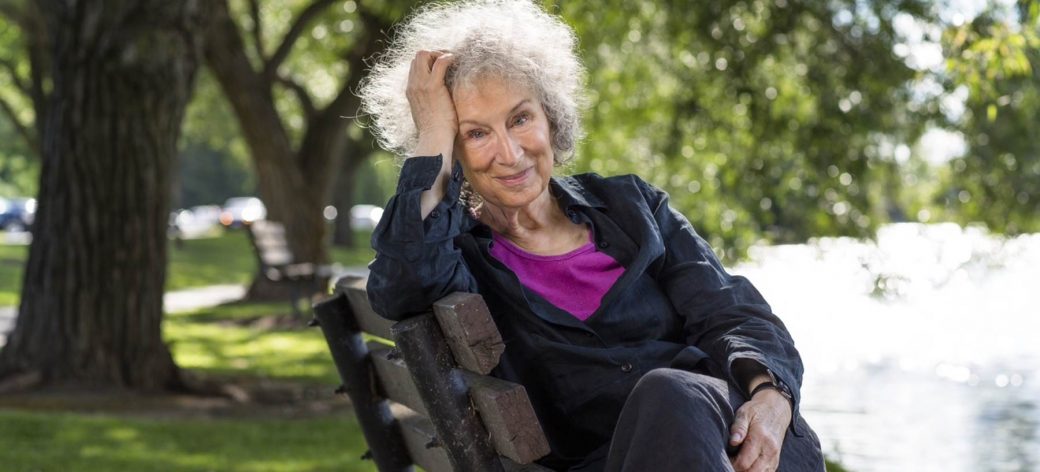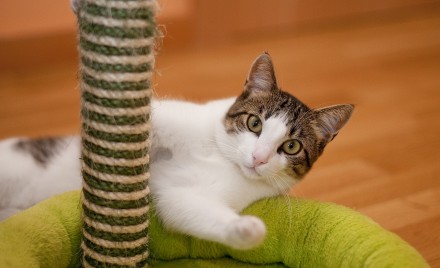Count Catula & Two Women for Nature: A Conversation

Bridget Stutchbury is a founding member of Women for Nature, author of Silence of the Songbirds and The Bird Detective, and a professor at York University. Since the 1980s, she has followed songbirds to their wintering grounds in Latin America and back to their breeding grounds in North America to understand their behaviour, ecology and conservation. Her latest research uses “geolocators” to track the amazing migratory journeys of Wood Thrushes, Purple Martins and Red-eyed Vireos.
We invited her to interview Margaret Atwood about their mutual interest in bird conservation, Angel Catbird, and the importance of Women for Nature. Volume 2 of Angel Catbird, To Castle Catula is available February 14, 2017. For a preview, click here.
B. In the introduction to Angel Catbird you wrote that you drew cartoons of flying cats when you were a child. I am wondering where you got the inspiration for the bat-cat-vampire character Count Catula?
M. Well I think it was just a natural because of his name. So, Dracula just naturally suggests ‘Catula’ when you are thinking in those terms. But he is one of my favourites and I hope we are going to be able to work in some bat conservation along the way.
B. How does Count Catula develop in Volume 2 of Angel Catbird?
M. Count Catula becomes a very helpful force on the side of the Angel Catbird and his friends. He helps them out quite a bit but he can only help them out at night, as you might expect. But we are going to find ourselves visiting Castle Catula and we will meet the wives of Catula. Count Dracula only had three wives as you will recall, but Count Catula, being a cat, has many more.
B. Angel Catbird is your first graphic novel. Why did you write this book?
M. As you know, this started its life as a way of thinking about one of the big threats to migratory songbirds, which are cats (both domestic and feral). It’s been a very hard issue for people in bird conservation to deal with because, of course, they can’t say “flush your kitty cats down the toilet” because nobody would do that and also, they would get very angry. And, having been a cat person, I know how people feel in that respect, so it seemed to me that the best solution would be to have a flying superhero who combined both cat and bird, and therefore could see both sides of the issue.
And, to join that at the hip with Nature Canada, who could provide the science and the website, where you get lots of hints about how better to take care of your cat and make it safer, particularly in cities where they have a high rate of being run over by cars and being attacked by other cats, raccoons, and foxes. So, if people really love their cats as much as they say, they ought to treat them more the way we treat dogs and take better care of them.
So that’s part of the campaign and the other part is also raising awareness of the issues, which a lot of people just don’t know about. In Volume 2, for instance, we introduce the window-strike issue. I don’t want to give away too many spoilers, but one of the evil super-villain’s weapons is a deployable glass window. We all know that it’s cats, windows, habitat loss and toxins that are the four apocalyptic threats to migratory songbirds. Although we are concentrating on the cats and birds, we can mention the others and get them in there.
B. Angel Catbird features humans who are part Snowy Owl or part Common Raven. If you were to want to represent yourself in a graphic novel as part-bird, I wonder what bird species would you choose?
M. Oh, absolutely a Raven! They are so smart and quite social. Although, if I couldn’t do that I would be the Gray Jay; they are also very smart. I am very fond of owls but there are a lot of birds that are not meat-eaters so if you are feeling pacifist that day you might choose a seed or fruit-eating bird, or maybe just a worm-eater.
B. How did you first get involved in bird conservation?
M. I grew up in it. My father was a biologist. You know that Graeme [Gibson, her partner of many years] is heavily involved as well, and he would be what you call a convert, he came to it later in life. I was just there amongst the biologists and that was just something people knew. Somebody came up to me last night and said I knew your parents and they were early members of the Sierra Club. So they were into it quite early on. My Dad was also a member Toronto Anglers and Hunters. It stands to reason that if you are fond of hunting and fishing you are going to want a place where you can do it. Where there are fish and things to hunt, so not a wasteland.
B. Many people seem unconcerned about biodiversity loss, climate change and environmental degradation despite all the scientific evidence and media attention it gets. Why do you think this is the case?
M. I don’t know whether they are absolutely unconcerned. I think that when the issues are that big, unless you give people something they can do, something they can engage with, they just feel helpless. So I think part of it is finding them points at which ordinary people, with not a lot of extra time on their hands, can make in their own area a small difference.
B. I am wondering if you were ever tempted yourself to become a field biologist?
M. I was tempted to become a biologist when I was in high school because I was quite good at it. And, unlike English literature, they didn’t take points off for spelling. I was quite good at spelling things like Ranunculus [(buttercup]) but I was bad at spelling things like weird.
My brother, you know, he did become a biologist. Our marks were the same. His English marks were the same as my English marks, and my biology marks were the same as his biology marks. And, I did botany in Grade 13 as a subject that I studied on my own, which worked out pretty well for me because I was able to use that as one of my top marks instead of my rather poor showing in Latin. But I think my Dad was always a little bit mopey that I had not become a botanist.
B. I am teaching a graduate course right now in Conservation Biology and this is something that we discussed yesterday in our class. That we are in the midst of the so-called 6th mass extinction in the history of our planet, the “Anthropocene”. Do you see any signs of hope that this mass extinction can be avoided? How do you feel about the future?
M. There have been some reversals in species that looked as if they were going down the tubes. For instance, pandas apparently have made somewhat of a comeback. And, as you know, Bird Life International is dedicated to preventing the extinction of every single threatened bird species. They have had quite a few successes. It looked as if Indian Vultures were going to be completely wiped out, for instance, until it was discovered that what was causing it was an antibiotic being used on cows. And, they were able to intervene once that was known, and persuade the Indian government to ban that particular one.
And now they’re working on the poachers who want to poison vultures because when you poach an elephant the vultures descend and their presence signals the authorities. It’s a clue to where that dead elephant is. They put poison in the dead elephant, and that kills not only the vultures but every single piece of wildlife that has anything to do with it.
I managed to work the vultures into Angel Catbird Vol. 3.
When the causes are known, and when they are specific, you can often do something about them, and the encouraging thing to me is that is that there are so many people all over the world in the Bird Life International partnerships, of which Nature Canada is one, who are dedicating themselves to this.
And, there are also now some green environmental but also financially viable projects going on with respect to the regeneration of tropical and sub-tropical forests and wetlands. It is known if you do regenerate the biodiversity that it is helpful to the livelihoods of the people who live there. So, if you combine a plus and a -plus, good for people and also good for biodiversity, then that can work.
B. What inspired you to become a member of the Women for Nature partnership that was created by Nature Canada?
M. I think it’s a very useful thing in that it creates a number of spokespersons who can speak directly to the connection between a good environment and things that might particularly concern women, such as the health of their children. Who doesn’t want healthy air, healthy water, and healthy food for their kids, and how do you get those things? How do you for instance test for those things? We have to have people who constantly telling us, doing the science, and saying “don’t drink this”.
We have to have the science but then we also have to have the communications. Women for Nature exists at the interface between people doing the science and people communicating the results and suggesting solutions. It’s no good to tell people don’t drink the water if there if there isn’t any good water they can drink.
B. Do you plan to continue to writing graphic novels after the Angel Catbird trilogy?
M. The next thing we are going to do with Angel Catbird is to turn it into an audio book like an old-time 1940s radio show. As for Angel Catbird volumes 4-6, we will see if Johnnie Christmas is up to it. It’s a lot of drawing, with Tamra Bonvilliain colouring it, and of course we have Dark Horse publishing it so we will have to see if the team is up for doing it. I’m up for it but other people have to be up for it too.
B. Thank you for time Margaret I really appreciate it. Do you have anything else you would like to add?
M. Well, it’s been amazingly more successful than I thought it would be. Angel Catbird has been, I think, 13 weeks on the New York Times bestseller comics and graphics list and it has acquired some cult followers.
Do you remember the Elmer the Safety Elephant? I think it would be great if Angel Catbird turned up in full costume with some of his friends and visited schools but that is pretty far down the line I think.
At Fan Expo we did have our first cosplay. Well, somebody had dressed up as Cate Leone in the full kit, she had everything, she had the ears and she had the outfit and she was just gorgeous. And that was our first cosplay and Johnnie Christmas said “that’s so early, usually you don’t get cosplay until a couple of years later” and we were very encouraged by that and then got a picture of me with her.











